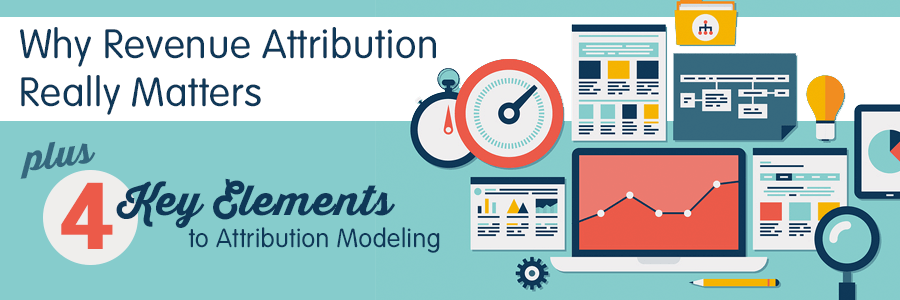
Why Revenue Attribution Matters and 4 Key Elements to Attribution Modeling
Table of Contents
“Half the money I spend on advertising is wasted; the trouble is I don't know which half.”
John Wanamaker
U.S. Merchant and Religious, Civic and Political Leader
”Revenue attribution is the process of matching customer sales to specific advertisements in order to understand where revenue is coming from and optimize how advertising budgets are spent in the future.” Source: WhatIs.com

The quotes above illustrate why attribution matters; it tells you which channels, which campaigns and which efforts within those campaigns are most and least effective at driving revenue. This allows you to do more of what works and less of what doesn’t.
Marketing coupons were one of the first tools that marketers used to track attribution.

When a customer used a coupon for a purchase the merchant was able to track it back to the source – giving them insight into where people were finding out about them, and where to continue spending marketing dollars.
In the online world, marketers use promo codes instead of coupons for the same reason.

While coupons and promo codes are good, they aren’t great solutions to the attribution issue.
First, in order to be effective, they need to include an offer that the customer won’t get without them. This is basically a way to compensate the customer for helping you track the effectiveness of your marketing efforts. So this type of attribution lowers your revenue.
Second, coupons and promo codes aren’t a 100% solution. The redemption rate on coupons and promo codes is very low; some people may be influenced by them but not use them. While you can extrapolate the results of your redemptions to your entire marketing program, you’re typically using a very small sample size and applying the findings to a large universe – which can result in a large margin of error.
So what’s an e-commerce company to do?
Here’s where developing and implementing an attribution model is helpful. You’ll likely to be able to explain 75% or more of your sales – and you can automate it, so the ongoing time and effort it takes to manage is minimal. Best of all, you don’t need any assistance from your customers (all they have to do is buy).
Elements of an Effective Attribution Model
There are four key elements to any attribution model:
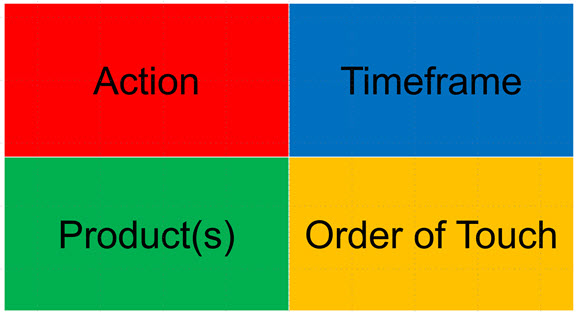
Let’s talk about each.
Action
This is the action that needs to occur to be included in attribution modeling – you need to define what will count. The most common actions are:
- Sent (for email or offline direct mail) or Served / Impression (for display advertising and search engine marketing)
- Opened (email only)
- Clicked (for email and display advertising)
Timeframe
This covers the period that you will include; it’s typically measured from days prior to the sale. Timeframe is heavily dependent on the length of your sales cycle; items with a longer sale cycle should look at marketing that happened further in advance of the sale. Some standard timeframes are:
- One week (7 days)
- Two weeks (14 days)
- One month (30 days)
- Three months (90 days)
Product(s)
Here we’re defining what products (revenue) being purchased will be included in the attribution. For instance, someone may have received a promotional email about Product A and no marketing about Product B, but then they purchase product A and product B.
Does the Product A email get credit just for revenue from Product A? Or will you give the Product A email credit for the revenue from both, assuming that the Product B ‘add on’ purchase would not have happened without the Product A promotional email driving that person to buy?
Here the options are typically:
- Just the product promoted
- The product promoted and all other items purchased in the same sale
Order of Touch
This is the fourth and final basic element of any attribution model; it defines which touchpoint(s) during the timeframe will be counted. Most attribution models use last touch, meaning that only the last marketing effort before the sale will be eligible for attribution. But there are other options to understanding conversion attribution modeling touches:
- First touch
- Last touch
- Any touch
Any touch is the most interesting one. In many instances the sale is the culmination of a couple marketing efforts, not just one. A customer might see a display ad, be interested, but not have time just then to follow-up. But an email they receive the next day might drive them to purchase. Any touch provides a way to give credit to marketing efforts that influenced the sale – but I recommend using this as an add-on to your direct attribution model, otherwise you may spread credit too broadly and make your model less effective.

Pulling it All Together for Revenue Attribution
Now you know all the elements of an effective attribution model – but how do you put them together to actually build a model?
The key to success with an attribution model is to explain as much of the revenue as possible in a way that allows you to judge, with a level of confidence, which of your marketing efforts are more and less effective. The best way to do this is to ‘test drive’ a few models and see what percentage of your revenue they explain.
A model which explains only a small percentage of your revenue isn’t very useful; a model that accounts for more revenue than you actually generated is, likewise, not very useful. Here’s a sample exercise to explain.
Attribution Exercise
Here we’re looking at channel-level attribution; let’s start with a calendar of marketing communications to a single buyer for the month of December 2013 (the date is well past but the methodology is still valid).
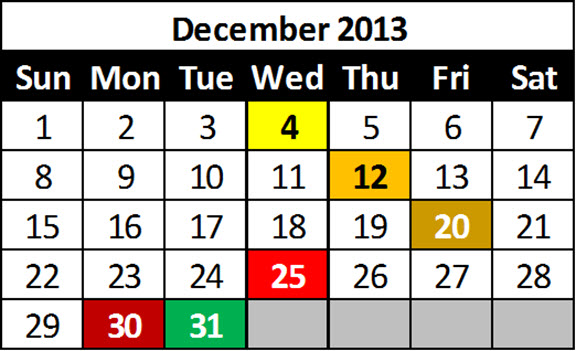
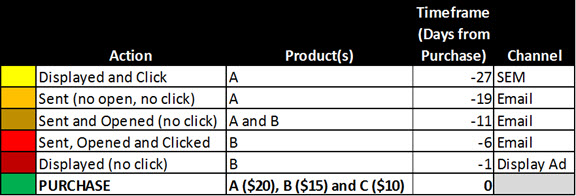
Over the course of the month this person clicked on a search engine marketing ad, received three email messages and was served a display ad. Here we’re attributing revenue by channel, not by individual marketing effort, but the methodology is the same if you want to look at individual efforts.
Now let’s see how different attribution models would divvy up the revenue on this $45 sale.
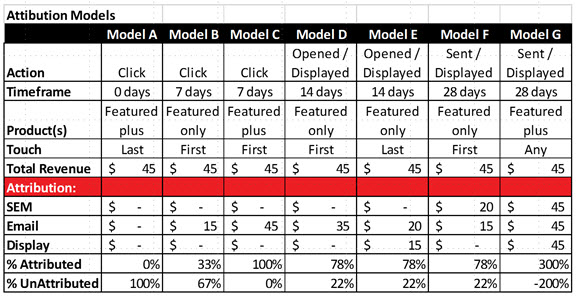
Model A is the tightest attribution model – It only looks at marketing that happened the day of the sale (Timeframe: 0). Here none of this revenue is attributed.
Model G is the broadest attribution model – any touch within a 28-day window is counted, even if there were no clicks or opens, and all revenue in the cart gets attributed to each. Here the revenue attributed is $135, or 3 times the total revenue generated.
Neither of these attribution models is a good fit; Model A doesn’t explain enough (it’s too tight) and Model G explains too much (it’s too broad). You won’t get the information you need to make good marketing decisions from either of these.
But let’s look at some of the models in the middle of the table. Models C, D, E and F are contenders – they explain between 78% and 100% of the revenue. The question is how to narrow it down to the one that provides the most insight into what is driving the sale. Hold that thought while we talk about test drives…
Test Drive
The exercise above focused on just one sale for simplicity to explain the attribution concept. When you do your test drive, you’ll want to look at all sales over a given period. The easiest way to do this is to look at past sales (with clients we typically go back a year) and apply different models to the same set of data.
For a test drive you’ll need:
- Information on all sales over a period
- Information on marketing efforts over the same period
In each case the information needs to granular and there needs to be a way to match marketing efforts to sales (typically this is email address, but it could also be customer ID or something else that appears in all both sets of data).
Then you define and apply different attribution models to the data to see which model explains the source of enough, but not too much, of your revenue. I try to get to at least 75% of revenue explained (but your results may vary). With clients we also spot check a sample of the sales to see if the attribution model makes sense at that level.
In Closing
This is a basic model but it’s a good place to start. As you get more sophisticated with your attribution you can layer on elements to give credit to marketing pieces that influence (but don’t directly drive) the sale, as well as site-based and company-based elements to account for sales driven by the marketing piece being passed to others in the organization.
The key to success is in understanding as much as you an about what’s driving sales – that allows you to do more of what’s working and less of what’s not. I can’t help but think that Mr. Wanamaker would have loved to have an attribution model like this for his business.
[Tweet “Why Revenue Attribution Matters and 4 Key Elements to Attribution Modeling”]
Pinpointe Newsletter
Join the newsletter to receive the latest updates in your inbox.

